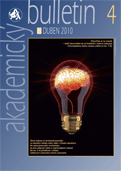Academy of Sciences of the Czech republic › Vědní oblasti › Life and Chemical Sciences
II. Life and Chemical Sciences
Professor Antonín Holý, the discoverer of new antiviral drugs, has died
17 Jul 2012

Syncytin – A good servant but a bad master
29 Feb 2012

White Nose Syndrome: Can Czech Bats Help American Bats?
20 Jan 2012

An Article by Czech Scientists in the Journal of Wildlife Diseases
Scientists from Moravian workplaces have proved that bats here suffer from white-nose syndrome, a fungal disease that is threatening the ecosystem in North America. In the Czech Republic as well as in other parts of Europe, bats with this syndrome die only very rarely and the disease has not yet caused a decline in the population numbers. Uncovering the cause of ‘European immunity’ could save North American bats and avert also the disruption of the biological balance in that part of the world.
The Discovery of the Principle of Timing the Activation of Memories in the Brain
13 Oct 2011

Discussions on Wheat Improvement in Paris
20 Sep 2011

DNA decorated by attachment of other molecules
9 Jun 2010
Scientists from the Institute of Organic Chemistry and Biochemistry ASCR have developed a novel simple and efficient methodology for attachment of other molecules to DNA. They prepared DNA bearing very reactive chemical functional groups that can be readily (in one step) linked to diverse other molecules e.g. for studying of molecular mechanism of important biological processes or for labeling of DNA by color or electroactive markers. This methodology has a promising potential for a broad range of applications in interdisciplinary area between chemistry and biology.
CONDUCTING POLYMERS - Formation, structure, properties, and applications
9 Jun 2010
10–14 July 2011 - 75th Prague Meeting on Macromolecules be focused on the main topic - CONDUCTING POLYMERS - Formation, structure, properties, and applications. Characterization of conducting polymers by spectroscopic methods. Modelling and simulations. Molar masses and molecular architecture. Electrical, magnetic, mechanical, optical and other physical properties of conducting polymers.
Consequences of being rich: wealth and population are key drivers of invasive species in Europe
10 Jun 2010

A new study of biological invasions in Europe found they were linked not so much to changes in climate or land cover, but to two dominant factors – more money and more people. Wealth and population density, along with an increase in international trade and commerce, were the forces most strongly associated with invasive species that can disrupt ecosystems and cause severe ecological or agricultural damage, scientists said.
Membrane lipids and cytoskeleton dynamics are intimately interconnected in plant cells
21 May 2010

Membrane lipids and cytoskeleton dynamics are intimately interconnected in the eukaryotic cell, but only recently have the molecular mechanisms operating at this interface in plant cells been addressed experimentally. F-actin microfilaments and microtubules are major constituents of the cellular cytoskeleton in plant cells as well. Nevertheless, plant cells are strained by developmental as well as environmental mechanical challenges because of the crucial structural and regulatory function of the cell wall.





